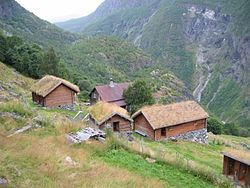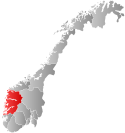|
Årdal
Årdal is a municipality in Vestland county, Norway. It is located at the end of the Årdalsfjorden in the traditional district of Sogn. The village of Årdalstangen is the administrative center of the municipality. The other main village is Øvre Årdal. The municipality of Årdal was created in 1863 when it was separated from the municipality of Lærdal. Årdal is a modern industrial community, with ties to the old society of farming and fishing. It is surrounded by dramatic nature with high mountains and waterfalls. The climate is rather mild and with less rain than normal in the west part of Norway. Årdal is a good starting point to explore the wild nature of Jotunheimen National Park, and with summer and winter activities within its boundaries. The Vettisfossen waterfall (highest in Norway) is located within the municipality.[4] The 977-square-kilometre (377 sq mi) municipality is the 119th largest by area out of the 356 municipalities in Norway. Årdal is the 179th most populous municipality in Norway with a population of 5,172. The municipality's population density is 5.6 inhabitants per square kilometre (15/sq mi) and its population has decreased by 6.3% over the previous 10-year period.[5][6] In 2016, the chief of police for Vestlandet formally suggested a reconfiguration of police districts and stations. He proposed that the police station in Årdal be closed.[7] Name The municipality (originally the parish) is named after the Årdalen valley (Old Norse: Árdalr) since it is the central geographical feature of the municipality. The first element is the genitive case of the word á which means "river" or "creek" (referring to the Utla river). The last element is dalr which means "valley" or "dale".[8] On 21 December 1917, a royal resolution enacted the 1917 Norwegian language reforms. Prior to this change, the name was spelled Aardal with the digraph "Aa", and after this reform, the name was spelled Årdal, using the letter Å instead.[9][10] Coat of armsThe coat of arms was granted on 9 August 1957. The official blazon is "Gules, three barrulets dancetty Or" (Norwegian: På raud botn ein gull trillingstreng med ormeband-skurd). This means the arms have a red field (background) and the charge is three zig-zag lines running horizontally across the escutcheon. The charge has a tincture of Or which means it is commonly colored yellow, but if it is made out of metal, then gold is used. The local economy at the time of the creation of the arms was mainly based on heavy industry, which needed a lot of electricity. The zig-zag lines in the arms symbolize both the electrical power and the industries. The zig-zag design also symbolizes the ormeband-skrud which is more or less translated as a "worm-ribbon ornament" which is a design of dragons and lindworms that were depicted in the ornamentations in the ancient Norwegian wooden stave churches in the area. The arms were designed by Hallvard Trætteberg, after an original idea by Magnus Hardeland. The municipal flag has the same design as the coat of arms.[11][12][13] HistoryLærdal was established as a municipality on 1 January 1838 (see formannskapsdistrikt law). The original municipality was identical to the Lærdal parish (prestegjeld) including the sub-parish (sokn) of Aardal. In 1863, the sub-parish of Aardal (population: 1,791) was separated from Lærdal and became a municipality of its own. The spelling was later changed to Årdal. During the 1960s, there were many municipal mergers across Norway due to the work of the Schei Committee. On 1 January 1964, the Muggeteigen, Luggenes, and Bergmål farms (population: 11) were transferred from Årdal to Lærdal.[14][15] Establishment of center for asylum seekersFrom 1 August 2013 to 1 September it received 151 asylum seekers.[16] (The municipal council had beforehand said no to establishing a center for asylum seekers, but the fylkesmannen resolved otherwise.[16]) On 4 November 2013, one of the residents of the center was found—with a knife in his hand—on the bus from Årdal to Oslo, together with one dead bus driver and two dead passengers. The incident is known as the Triple murder on the Valdres Express,[17] and only one male[18]—the asylum seeker—is a police suspect. Earlier on the same day, for the first time one of the center's asylum seekers was removed (by police) in order to be deported from Norway.[19] (After the deaths, media said that Norway has no requirement for screening the mental health of asylum seekers—unlike requirements in Netherlands.) GovernmentÅrdal Municipality is responsible for primary education (through 10th grade), outpatient health services, senior citizen services, welfare and other social services, zoning, economic development, and municipal roads and utilities. The municipality is governed by a municipal council of directly elected representatives. The mayor is indirectly elected by a vote of the municipal council.[20] The municipality is under the jurisdiction of the Sogn og Fjordane District Court and the Gulating Court of Appeal. Municipal councilThe municipal council (Kommunestyre) of Årdal is made up of 21 representatives that are elected to four year terms. The tables below show the current and historical composition of the council by political party.
MayorsThe mayors (Nynorsk: ordførar) of Årdal:[40]
Geography The municipality is situated at the inner part of the Årdalsfjorden, one of the beginning branches of the Sognefjorden and is a gateway to the mountain areas called Jotunheimen and Hurrungane, including the mountains Falketind, Store Austanbotntind, and Store Skagastølstind. There are two urban areas in Årdal: Årdalstangen and Øvre Årdal, with a total population of approximately 5,700. There are also smaller village areas throughout the municipality: Naddvik (Vikadalen), Nundalen, Indre Offerdal, Ytre Offerdal, Seimsdalen, Fardalen, Avdalen, Utladalen, Vetti, and Vettismorki.[4] Årdal is bordered to the north and west by the municipality of Luster, to the east by Vang (in Oppland county), and to the south by Lærdal. IndustryÅrdal became a symbol of modern Norway after World War II. In the course of a few years, Årdal was transformed from a scarcely populated rural community into a small town situated around the aluminium plant Årdal og Sunndal Verk. Construction of the aluminium plant at Årdal started in 1941. The purpose was to build a large aluminium industry as a part of the German war effort. The Norwegian State confiscated the unfinished plant in Årdal in 1945 at the end of the war. The plant was finished by the government and production started in 1948. At Årdal, the aluminium factory produced semi-finished aluminium that went on to be transformed into various products in other factories. During the early years most of the aluminium was exported. The car and airplane industries were big aluminium consumers. Some finished products were made in Norway, such as Høyang kitchen equipment, kettles, and pans. In 1986, Årdal og Sunndal Verk was merged with Norsk Hydro under the name Hydro Aluminium AS.[42] ChurchesThe Church of Norway has two parishes (sokn) within the municipality of Årdal. It is part of the Sogn prosti (deanery) in the Diocese of Bjørgvin.
AttractionsUtladalenThe Vettisfossen waterfall was given protected status in 1924. With a free fall of 275 metres (902 ft), it is the highest waterfall in Northern Europe. The Vetti Gard og Turiststasjon, a farm rich in tradition dating from around 1120, is set in dramatic natural surroundings. The farm has been involved in tourism ever since the early 19th century and now serves as a café and tourist information office in the summer. The Vettismorki mountain farm is located nearby. The Utladalen Landscape Protection Area (314 square kilometres or 121 square miles) was established in conjunction with the Jotunheimen National Park. It comprises large parts of the Utladalen valley and adjoining side valleys. The area contains several old farms and mountain pasture farmsteads of historical interest. Utladalen Naturhus is a nature center situated at Skåri, an old farm. Farming here ceased in the early 1970s. In 1996 work commenced on the restoration of the old cultural landscape, and the Utladalen Naturhus center was opened in May 1998. Run by the Utladalen Naturhus foundation, the aim of the centre is to inform visitors about the natural and cultural history of Utladalen and Western Jotunheimen. The centre also includes the Slingsby Museum.[4] Avdalen Gård (Farm) The Avdalen farm is scenically situated on the mountainside above the beautiful Avdalen waterfall in the Utladalen valley. The land was cleared for farming in the 16th century. Abandoned in more recent times, the farm has now been restored to provide restaurant, accommodation and meeting facilities. The mill house can be seen in operation milling grain.[4] Jotunheimen National ParkThe Jotunheimen National Park, established in 1980, covers an area of approximately 1,145 square kilometres (442 sq mi) and comprises the Hurrungane, Fannaråki, and the Rauddalstind og Mjølkedalstind peaks. Jotunheimen is a popular area for hiking in summer and skiing in winter, and the Hurrungane massif is very popular with climbers.[4] Indre Offerdal MuseumThis old fjord-side settlement of Indre Offerdal "right down by the shore" is packed with interesting history about Årdal. Ten buildings, including a mill, sawmill, a shoreside warehouse, and farm buildings dating from the 19th century, provide insight into the beginnings of the extensive industrialization of this local community.[4] Scenic Views
Notable people
Historical societyThe group called Årdal Sogelag concerns itself with local history. TransportationThe Valdres Express stops in Øvre Årdal and has its end stop in Årdalstangen. The bus line originates from Oslo. References
External links
|
|||||||||||||||||||||||||||||||||||||||||||||||||||||||||||||||||||||||||||||||||||||||||||||||||||||||||||||||||||||||||||||||||||||||||||||||||||||||||||||||||||||||||||||||||||||||||||||||||||||||||||||||||||||||||||||||||||||||||||||||||||||||||||||||||||||||||||||||||||||||||||||||||||||||||||||||||||||||||||||||||||||||||||||||||||||||||||||||||||||||||||||||||||||||||||||||||||||||||||||||||||||||||||||||||||||||||||||||||||||||||||||||||||||||
Portal di Ensiklopedia Dunia





